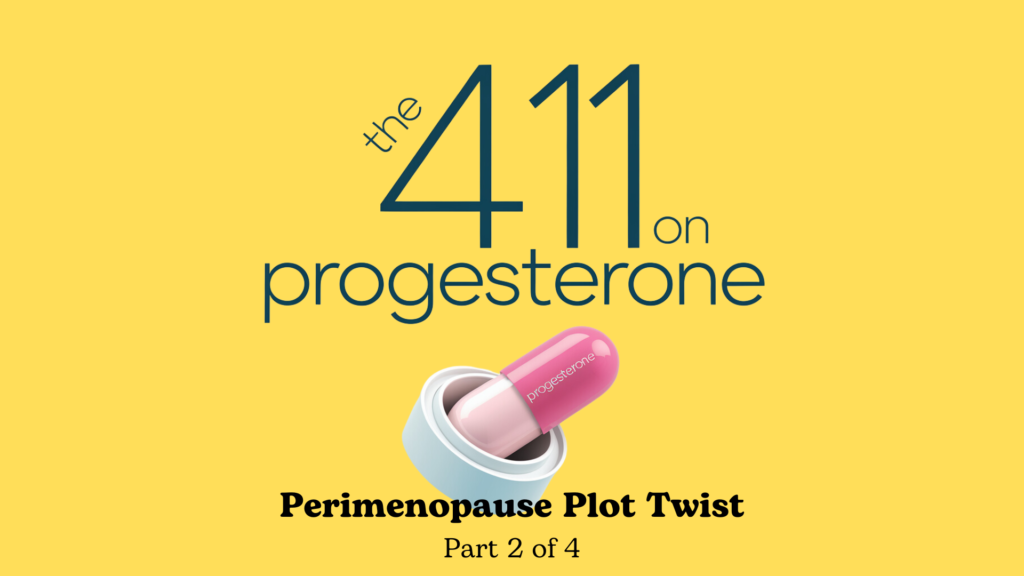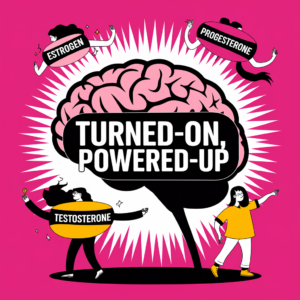“I am not myself. I can’t sleep. I keep yelling at my kids, and I’ve never been this anxious. I feel like I’m falling apart and don’t know what to do about it.” – Karry, age 46.
Perimenopause is a time of massive change and every woman experiences it differently. This oh-so-fun transition begins 5-10 years before menopause, so it’s not uncommon to see changes starting as early as age 35-40. Because the symptoms of perimenopause can vary so much between women, it’s common to seek medical care from multiple medical providers before getting to the bottom of the perimenopausal plot twist. Luckily, progesterone supplementation can make a massive difference during perimenopause.
If you’ve been following along in my hormone series, you met progesterone in my last article – the demure, steady hormone that keeps things running smoothly behind the scenes. Today, we’re diving into why this unsung hero becomes particularly important during perimenopause and why it might be the secret weapon you didn’t know you needed.
The Perimenopause Plot Twist
Here’s something that might surprise you: progesterone, not estrogen, is typically the first hormone to decline as you enter perimenopause. While most of the conversation around menopause focuses on estrogen, it’s actually your progesterone levels that start dropping first, often years before you notice any other changes.
This early decline makes perfect sense when you understand the science. Remember: progesterone is primarily produced by the corpus luteum – the remnants of your “golden egg” after ovulation. As you enter perimenopause, you start having more cycles where you don’t ovulate (called anovulatory cycles). No ovulation means no corpus luteum, which means no progesterone production during that cycle’s second half (luteal phase).
The “Estrogen Dominance” Dilemma
In early perimenopause, your average estradiol level is 20-30% higher than it was in pre-menopause. It’s not just high, though – it’s chaotic and unpredictable, sometimes skyrocketing up before crashing down in all its dramatic glory! These crazy ups and downs can cause even the most even-keeled gal to feel unwound.
At the same time, progesterone starts declining. You can end up in a state of “estrogen dominance” (which isn’t really a medical term but makes sense nevertheless). Think of it like a dance where one partner suddenly steps back – just as the other partner starts twerking aggressively, out of time with the music – the balance is off, and the whole performance suffers.
Pre-Menopausal Progesterone Benefits
Even before perimenopause, progesterone can be beneficial for managing a variety of hormone-related challenges. Some key indications for progesterone support in pre-menopausal women include:
- Severe PMS
- Menstrual migraines
- Luteal phase deficiency
- Sleep disorders
- Endometriosis
- Fibrocystic breasts
- Ovarian cysts or uterine fibroids
- Anxiety with a cyclic pattern
- Irregular or absent menstrual cycles (ex: PCOS)
- Fertility and early pregnancy support
- Postpartum depression
Progesterone: The First Line of Defense
While many healthcare providers jump straight to estrogen therapy when women start experiencing perimenopausal symptoms, progesterone alone can often provides significant relief, especially in early perimenopause. Here’s why:
- Sleep Support: Progesterone has natural calming effects on the brain through its interaction with GABA receptors (strongest when using oral progesterone). This can help with the sleep disruption that often occurs during perimenopause.
- Mood Stabilization: By balancing estrogen’s effects and supporting neurotransmitter function, progesterone can help manage the mood swings and anxiety common during this transition.
- Temperature Regulation: Contrary to popular belief, hot flashes can occur due to progesterone deficiency, not just estrogen deficiency. Some women find complete relief from hot flashes with progesterone alone during perimenopause.
- Menstrual Normalization: For women still having periods, progesterone can help regulate heavy or irregular bleeding, a common perimenopause complaint.
The Timing Question
During perimenopause, when to take progesterone becomes an important consideration. The approach depends largely on your primary concerns and symptoms.
Remember: Day 1 of your cycle is the first day you bleed. Ovulation occurs at about Day 14. The follicular phase is before ovulation (days 1 – 14). The luteal phase is after ovulation (days 15 – 28). Every woman’s cycle is slightly different.
For Women with Regular Cycles:
Hormonal changes regulate the menstrual cycle. During a natural cycle, the sharp decline in progesterone at the end of the luteal phase (around day 28) triggers menstrual bleeding by destabilizing the uterine lining. When supplementing with progesterone, mimicking this natural pattern helps maintain regular cycles. (source)
Progesterone Supplementation Cycled Approaches:
- Late Luteal Phase (Days 21-28)
- Shortest supplementation window
- Focuses on the critical pre-menstrual period
- Full Luteal Phase (Days 15-28)
- Covers the entire post-ovulatory phase
- Provides more comprehensive hormonal support
- Extended Cycle (Days 5-28)
- Longest supplementation window
- Offers sustained hormonal support throughout most of the cycle
- Combination Approach
- Daily low-dose progesterone plus higher doses during luteal phase
- Particularly useful for women who benefit from continuous support while maintaining regular cycles
Clinical Applications: Cycled progesterone supplementation can benefit women with:
- Premenstrual symptoms (PMS, anxiety, migraines)
- Menstrual difficulties (heavy or painful periods)
- Reproductive health conditions (fibrocystic breasts, uterine fibroids, endometriosis, ovarian cysts)
- Early perimenopause symptoms.
For Women with Irregular Cycles:
For women with unpredictable menstrual cycles, daily progesterone supplementation often provides better outcomes than cycled therapy. However, working with a healthcare provider to determine the underlying cause of cycle irregularity before starting any treatment is essential.
Why Daily Instead of Cycled?
- Provides consistent hormonal support throughout the month
- Eliminates the need for precise cycle tracking
- Offers more reliable therapeutic benefits when ovulation is irregular
- Helps maintain endometrial health
Clinical Applications: Daily progesterone therapy can be particularly beneficial for:
- Women with PCOS and irregular ovulation
- Those at risk for first-trimester miscarriage
- Individuals experiencing postpartum depression
- Women managing endometriosis or uterine fibroids
- Those with hormone-related anxiety or insomnia
- Women in late perimenopause with irregular cycles
Progesterone Therapy After Uterine Procedures
For pre- or peri-menopausal women who no longer experience menstrual bleeding due to surgical procedures but retain their ovaries, progesterone therapy may still be beneficial. This includes women who have undergone:
- Partial hysterectomy (uterus removal with ovaries intact)
- Uterine ablation
- Uterine artery embolization
Treatment Options:
- Daily Progesterone
- Provides consistent hormone support
- Simplifies treatment schedule
- No tracking required
- Cycled Progesterone
- Mimics natural hormone patterns
- Requires tracking ovulation
- Best monitored through basal body temperature (BBT) measurements, which typically rise after ovulation
Important Note: Even without menstrual bleeding, women may still experience symptoms of low progesterone that can be effectively managed with supplementation. The choice between daily or cycled therapy should be based on individual symptoms and preferences.
Looking Ahead
As you progress through perimenopause and into menopause, your progesterone needs will change. While you might start with progesterone alone, most women eventually benefit from adding estrogen therapy as well. However, the foundation laid by understanding and optimizing your progesterone levels early in the transition can make a significant difference in your perimenopause journey.
In my next article, I’ll dive deep into the nitty-gritty details of how to take progesterone – from different forms and delivery methods to specific dosing strategies. If you’re not already a paid subscriber, this is the time to sign up. The next two articles require you to be a paid subscriber. They’ll be worth it – I promise!
Author’s note: This article is part of a series on hormonal health and optimization. Always consult with your healthcare provider before making changes to your hormone management strategy. And, of course, this series is for informational purposes only and does not constitute medical advice… yada yada yada. :))












